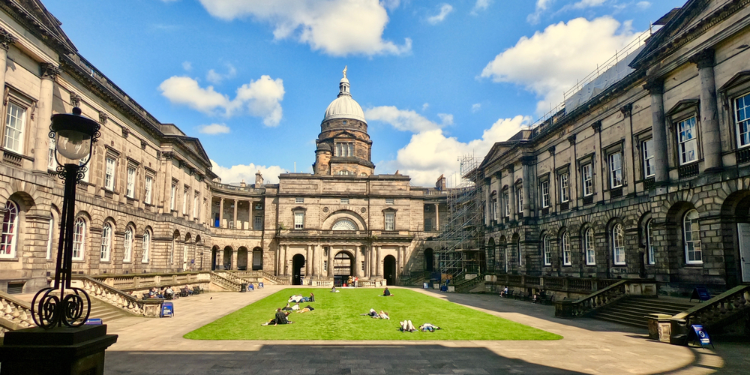
University, liberal arts college, community college, vocational universities – what is the difference between all of these types of post-secondary educational institutions? Choosing a type of institution can be a confusing matter for international applicants whose home country might have a completely different education system. Below, we summarize the main kinds of post-secondary institutions.
Universities offer both undergraduate and postgraduate programs and tend to be research-intensive
Universities are the most commonly known higher education institutions. They are often associated with large student body and faculty sizes, but that is not necessarily true. The real mark of the university, especially as opposed to the “college” in a country like the US where both terms exist, is that the university offers a wide variety of postgraduate programs in addition to undergraduate programs.
Universities have an extensive offering of master's and doctoral programs, which means that they also tend to be research-intensive. Other types of institutions don't have many PhD-level course offerings and much doctoral funding, but universities nearly always do.
Even if universities don't necessarily need to be big, that is often true. They tend to have a high student-to-professor ratio, which means that many classes are taught in large and fairly impersonal lecture theaters. Large national and regional public universities tend to attract most of the students who graduate from high school in the area.
To give an example, Texas A&M University, a large public university in the US state of Texas, has around 75,000 students at a time. Over 90% of these students are from the state of Texas itself, and they benefit from lower in-state tuition. About 6,000 are international students. In another part of the world, the University of Delhi, one of the biggest and most prestigious public universities in India, has around 130,000 students across all levels at a time. They tend to come from all over the country. It has a small number of international students, around 700, some of whom are on scholarships.
Large classes can feel isolating, but on the plus side, a large student population also translates to a lively and diverse campus life. Universities generally have many student associations and clubs for everything from sports to faith-based activities to robotics. In the US, Canada and the Philippines, universities also have fraternities and sororities that students can join to feel like they are living with a family. These are single-sex groups that carefully select their members (based on criteria like community service contributions) into their community of friends, a community that sometimes lives in a single fraternity/sorority house. They do activities together like weekly dinners, spa nights, games nights and picnics.
Large universities, especially those with various “colleges” (smaller schools) and departments, have campuses that are like miniature and highly walkable towns. Most students live on campus and can walk or ride their bikes to their lecture theaters, their labs, the other dorms in which their friends live, the library, the gym, and even on-campus grocery stores and hair salons. The campuses of all large public Chinese universities are like this (e.g., Shanghai Jiao Tong University, Tsinghua University in Beijing). Ivy League universities in the United States are the same. The universities of Oxford and Cambridge in the UK, which are divided into colleges, have similar campuses which feel like cozy, self-enclosed towns.
What are colleges within a university? Confusion often arises concerning the difference between colleges within a larger university and stand-alone institutions called colleges (which are not part of any university). Sometimes, “college” is synonymous with “department,” whereby “College of Engineering” simply means “Department of Engineering.”
However, in certain universities, notably Oxbridge (Oxford and Cambridge) and Durham University in the UK, or the University of Otago in New Zealand, “colleges” are more akin to residential communities with their own unique history and “personality.” They have their own traditions, events, dorms, study rooms and common rooms. It might be useful to think of them as similar to the four houses in the Harry Potter universe.
Sometimes, different universities are part of the same system. The University of Paris, for instance, is not a single university but a system of seven universities scattered around the French capital. They used to be a single university before 1970, but they've since been split into various universities – some of which don't have certain departments. Its seven universities include the prestigious Sorbonne University, which has a humanities and science/medicine department. This one has the largest student body of the seven (around 60,000 students) and is in the heart of the city. Meanwhile, Paris-Panthéon-Assas University is focused on programs in law, economics and political science. The smaller New Sorbonne University has only humanities programs.
Other university systems around the world are the University of London system (which includes King's College, Birbeck, Goldsmiths, the Royal Academy of Music, etc.) and the University of California system (UCLA, UC Berkeley, UC Davis, etc.). The advantage of studying at a university that is part of a larger system is that you can also access the resources (libraries, archives, study rooms) of all other universities within the system. It's also easier to transfer between universities within the same system or seek a co-supervisor for your thesis from a university within the same system.
Universities can be either public (i.e., state-owned) or private. Public universities tend to have much lower fees. However, private universities are able to offer more financial aid to international students, while public universities reserve their financial aid for local students.
The prestigious Ivy League universities in the US, for instance, which are all private, offer generous needs-based and merit-based financial aid to the best of international students. International students who are able to get admitted to these competitive schools but whose families make less than a certain amount of dollars per year are given a tuition-free education by the university. Harvard waives tuition fees for any undergraduate student whose family makes less than US$75,000 per annum, and Princeton does the same for those whose families make less than US$65,000.
Another difference between various universities is whether they make undergraduates choose their field of specialization prior to enrolling or allow them to take a variety of first-year classes before making a decision. In most parts of the world, undergraduates need to apply for a specific degree, such as a BSc Economics or BA English.
However, some universities have a liberal arts system that allows you to take various classes in your first semester or year before deciding on a major/specialization. That is the norm in all American universities, but it also exists in many Canadian universities, including prestigious ones like McGill University and the University of Toronto. However, some of their most competitive faculties require students to apply specifically to that faculty. For instance, those who want to study engineering at McGill need to apply specifically to its competitive Faculty of Engineering.
Colleges focus on undergraduate programs and have smaller professor-to-student ratios
Colleges are distinctly American higher education institutions. This does not concern “colleges'' within a British or New Zealand university, as explained in the previous section. Neither does the word mean “high school” as it does in many parts of the world. Instead, these are stand-alone higher education institutions akin to small universities, which focus on a broad undergraduate liberal arts education. They are often called “liberal arts colleges” if taking a wide variety of general education courses is a requirement for all students.
Most colleges are private, although there do exist some public colleges. Some prestigious liberal arts colleges are Williams College in Massachusetts, Amherst College in Massachusetts, Pomona College in California and Swarthmore College in Pennsylvania. Some colleges are even women-only: Barnard College in New York, Smith College in Massachusetts and Spelman College in Georgia are a few examples.
International students in the US might not apply to liberal arts colleges because of four misunderstandings. First, they might think that these are high schools because back in their country, “college” means “high school.” Second, they might think that these schools are less prestigious than those with “university” in their name. This is not true, for some liberal arts colleges like Amherst or Swarthmore are as selective and as prestigious as Ivy League universities.
Third, they do not think that liberal arts colleges can give them financial aid. As most liberal arts colleges are private and many are financially well-endowed, sometimes thanks to wealthy alumni, they are able to offer generous financial aid packages to international students – even full rides.
And fourth, aspiring scientists and engineers might think that liberal arts colleges teach only classes in the arts and humanities. No, liberal arts colleges have fully-fledged science, engineering and technology departments. But, because of the general education requirements, these schools train biologists and computer scientists who are also highly knowledgeable about literature and gender studies. It's a requirement to take courses outside of your major/field of specialization.
Hence, if you want a technical career in STEM combined with a solid humanistic education, a liberal arts college might be the perfect place for you to study. Of course, because of their very nature, liberal arts colleges are also ideal for those who aspire to an artistic career. They tend to have very well-established creative writing and theater programs, and their small class sizes nurture artistic mentorships.
Indeed, the last point might be the biggest draw of liberal arts colleges: small professor-to-student ratios, which makes for an intimate and highly personalized educational journey. Some students might thrive off the buzz and energy of large universities, but others might prefer cozier classes where they are able to have extended conversations with the professor and all of their classmates. In larger universities, that is only possible in seminars.
Community colleges offer associate's degrees, diplomas and certificates – but not 3-year or 4-year degrees
The community college is also a predominantly North American institution that exists in the US and Canada. In most other countries, their role is fulfilled by polytechnics, small training institutes that offer short courses, or open universities (e.g., “universidades populares” in Spain).
The main difference between community colleges and liberal arts colleges is that the former does not offer 3-year or 4-year degree programs. They only offer short courses that range between 6 months to 2 years. A 2-year post-secondary qualification is called an associate's degree. It is half of an undergraduate degree. Often, students complete their associate's degree at a community college before transferring to a university or a liberal arts college for the remaining 2 years of a bachelor's degree. Why might they choose to start their bachelor's degree at a community college? Lower entry requirements, flexibility and cost are key reasons why.
Community college is thousands of dollars cheaper than any university or liberal arts college. Community College Review reports that in 2023, the average yearly community college tuition fee for out-of-state students in the US, which includes international students, is around US$8,500. In contrast, the most affordable universities or liberal arts colleges cost at least $US15,000 per year. If you dream of studying in the US but are strapped for cash, you could consider attending a community college and later transferring to a university/liberal arts college.
On the downside, community colleges might not have as wide of a range of courses as universities and liberal arts colleges. If you are interested in a very niche or specialized subject, you're unlikely to find classes for it at a community college. There is also little scope for research there. The range of clubs and extracurricular activities will also be limited, and you might find it harder to make friends at a university and integrate into its culture when you transfer there only as a third-year student.
Community colleges will allow you to meet a wider range of non-traditional students you would rarely meet at more traditional schools. You will meet older adults with children who are returning to school, military veterans, part-time workers, and elderly students who are taking general interest courses to keep their minds sharp. Two-thirds of community college students are studying on a part-time basis, which means that you'll have more flexibility to take evening or weekend classes as well as work while studying.
Admission is not competitive either. You simply need to have a high school certificate, even if it's with borderline passing grades. As an international student, you also need proof of basic English proficiency. Some community colleges accept IELTS scores as low as 3.5, which is the lowest score of B1 (lower intermediate) proficiency. If you didn't get good grades in high school and couldn't get admitted to the universities/liberal arts colleges you wanted, you could try attending a community college first, getting good grades in your first two years there, and then transferring to your dream school.
Vocational universities have various names, but they are all industry-oriented rather than research-oriented
Polytechnic university, vocational university, university of applied science and technology, higher technical institute, institute of technology – they have different names around the world. In Australia, their official designation is TAFE (Technical and Further Education) institutions. In Germany, they are “fachhochschule,” and in the Netherlands, they are “hogeschool (HBO).” But they all designate universities that are not oriented towards research in the arts and sciences but rather towards practical industry skills.
In fields like IT, engineering and nursing, some of their course offerings might overlap with academically-oriented universities, but they also offer courses in skilled manual trades and fields like hospitality, music performance, sports, culinary arts and hairdressing that academically-oriented universities simply don't offer. The programs always involve work placements and practical assessments, sometimes even as a replacement for a thesis or any kind of research. They have strong industry connections and guide students directly into the workplace.
Vocational universities have some postgraduate offerings, but most of their courses tend to be bachelor's degrees as well as diplomas and certificates. The latter two are shorter in duration and also more affordable. For instance, 2-year vocational courses in the UK, also called Level 3 qualifications, tend to cost around £8,000 per year, while academic degrees cost an average of £22,000 per year. If an institution is called a “vocational school” or “training school” and doesn't bear the word “university” or “institute” at all, it will be one that offers exclusively diplomas and certificates.
The entry requirements of vocational universities are also often lower than those of academically-oriented universities. For certificates and some diploma programs, you often don't even need to have completed all of high school. You might need to submit the grades for only the first few years of high school. After getting your diploma, you can do a bachelor's degree in the field – even if you never graduated from high school.
Vocational courses sometimes have a lower reputation than academic courses, and that is because, in the past, the jobs associated with them tended to be blue-collar. But these are exactly the jobs that are now highly in demand in many countries, and they now often pay as well as office jobs. In countries like Canada and the UK, skilled trades like plumbing and carpentry count as priority jobs, so those with vocational qualifications get fast-tracked for immigration.



















